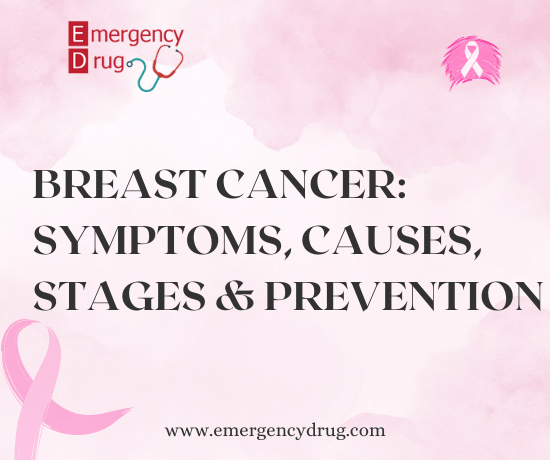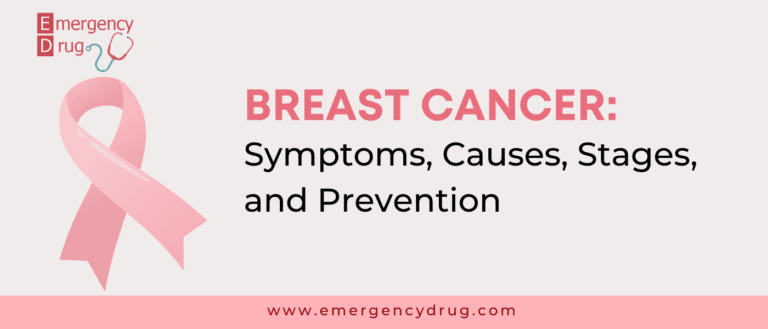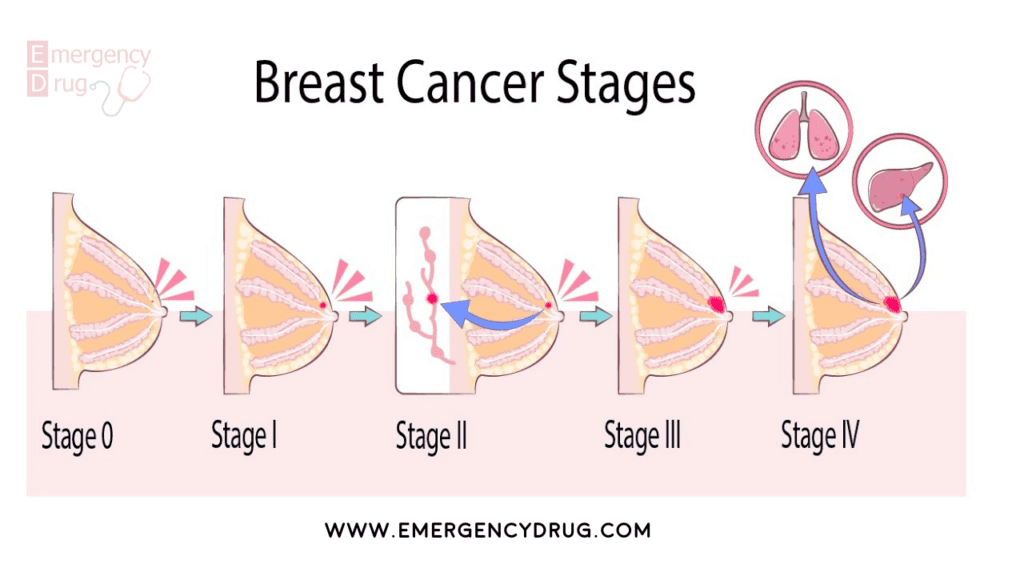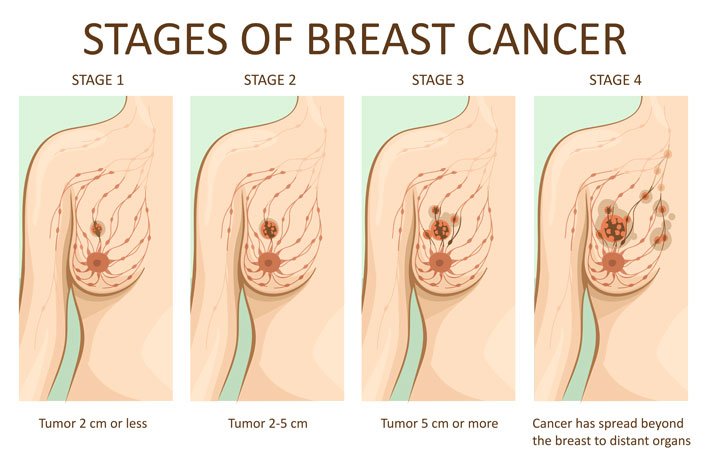Breast Cancer: Symptoms, Causes, Stages and Prevention
Hasan
04 Dec, 2022


Table of Contents
Introduction
After skin cancer, breast cancer is the most common cancer diagnosed in women worldwide. Men and women can develop breast cancer, but women are more likely to do so. Breast cancer survival rates have also improved due to this support, earlier detection, a better understanding of the disease, and personalised treatment approaches.
What is Breast Cancer?
Breast cancer is caused by the abnormal growth of cells in the breast. Different types of breast cancer arise from other types of cells.There are different places on the breast where breast cancer can begin. The breast has three main parts: lobules, ducts, and connective tissue. The lobules contain milk-producing glands. The tubes carrying milk to the nipple are called ducts. Everything is held together by connective tissue. In most cases, breast cancer starts in the ducts or lobules.Most breast cancers begin in the milk sacs or lobules, not the milk ducts. If the disease progresses to an advanced stage or metastasises, it can spread to the bones and other body parts, which increases the patient’s mortality risk. Breast cancer risks rise with age. Most confirmed breast cancer cases are after age 50. Tucaxen (Tucatinib) 150 mg tablets are used as targeted therapy for HER2-positive breast cancer
Where It Begins?
Breast cancer may start from various parts of your breast. A breast is an organ on top of your chest muscles and upper ribs. There is a right and left breast, both of which have fatty tissue, ducts, and glands.In women, the breasts deliver and make milk to feed infants and newborns. The fatty tissue amount in your breast dictates the size of both. So, in general, breast cancer can occur in the following parts of your breast:
- Connective tissue
- Nipples
- Lobules
- Lymph vessels
- Blood vessels
- Ducts
Types of Breast Cancer
There are many types of breast cancers affecting most women out there. But the most common types of breast cancers include-
Ductal carcinoma in situ: This is also referred to as stage breast cancer. Some regard it as precancerous since the cells have not spread to the milk ducts. The condition is treatable, but prompt care will be necessary to prevent cancer from spreading and becoming invasive.
Infiltrative ductal carcinoma: It starts in the breast’s milk ducts. Since it breaks through duct walls and can spread in the surrounding tissue, it makes up around 82% of all cases, making it the most common form of breast cancer.
Lobular carcinoma in situ: This is a precancerous illness with usually abnormal cells at the breast lobules. Although it is not true cancer, it may show potential for breast cancer. This makes it imperative to have clinical breast examinations regularly.
Infiltrative lobular carcinoma: Infiltrative lobular carcinoma occurs at the breast lobules and may spread to the surrounding tissues. Usually, it accounts for about 14% of all breast cancers.
Causes of Breast Cancer
Heredity
If you have a family member who has had breast cancer, the chance that you will also have the disease is very high, especially for women.Breast cancer caused by genetic mutations accounts for about 5-7%. In particular, inherited BRCA1/2 gene mutations can occur in both women and men. This gene mutation increases the risk of breast cancer, ovarian cancer, and other cancers. This is hereditary, and we cannot change it. Besides, some other genetic mutations can also cause breast cancer.
Body condition
Early menarche before age 12 or late menopause after age 55 expose women to more prolonged hormone exposure, increasing the risk of breast cancer. People with dense breast tissue with more fatty connective tissue are also thought to have a higher risk of breast cancer.
Using drugs and radiation therapy
Radiation therapy to the chest area (such as Hodgkin’s lymphoma) increases your risk of breast cancer.Heavy and frequent use of hormonal drugs. Some forms of hormone replacement therapy (including estrogen and progesterone) taken during menopause may increase the risk of breast cancer when taken for more than five years. Certain birth control pills (birth control pills) have also been found to increase the risk of breast cancer.
Stimulants: alcohol, beer, tobacco
Stimulants or alcoholic beverages are consistently among the leading causes of cancer, including breast cancer. It can be followed by: alcohol, beer, and tobacco.
Risk of weight and obesity
A University of Portsmouth study found that overweight or obese women are about 2.5 times more likely to develop some forms of breast cancer than those of a healthy weight. Obesity is associated with elevated estrogen levels, which can trigger the development of breast cancer. The risk increases as BMI rises above 30, especially after menopause.
Unhealthy lifestyle, staying up late
An unhealthy lifestyle, a sedentary lifestyle, and staying up late are the causes of breast cancer and many other gynaecological diseases.
Staying up late will inhibit the production of melatonin – A hormone produced by the pineal gland in the brain, produced when sleeping in the dark; usually, 11 pm – 4 am.
The hormone melatonin has the function of controlling the sleep cycle and helping to prevent the formation of tumours. There is an opportunity for tumour growth when melatonin levels are low. Staying up late will be the germ for developing breast cancer.
Who is at risk?
Based on the causes of the disease, we have a group of people at high risk of getting the disease:
- People with a family history of breast cancer.
- People with a history of diseases such as cysts, fibroadenomas, uterine cancer, ovarian cancer, etc.
- Women who have fertility problems such as infertility want to donate.
- People often have toxic chemicals and radiation.
Signs and Symptoms of Breast Cancer
In the early stages of breast cancer, the illness might cause symptoms. Mostly, a tumour can be too small for you to feel it. However, an abnormality will still be observed on a mammogram.
If you feel a tumour, the first sign can be a new lump in your breast which wasn’t there before. It is important to note that not every lump is cancerous.

All types of breast cancers may cause symptoms. Most of those symptoms are the same, but some are different. The most common symptoms and signs of breast cancer are –
- Inverted nipple
- Breast pain
- Swelling or lump under the arm
- Flaking, scaling, or peeling of skin
- Blood discharge
- Thickening tissue
- Discoloured or pitted skin on your breast.
Stages of Breast Cancer

Breast cancer is divided into five stages. The division of steps is based on the number of cancer cells, tumour size, the extent of spread, and metastasis (diagnosis by location TNM disease, abbreviated). Of Tumor (T) – Nodes (N) – Metastasis (M).Breast cancer staging factors:
- Cancer has invaded other breast tissues or cancer in situ (not invasive).
- The size of the cancerous mass.
- Cancer is present in the lymph nodes. Location and number of metastatic nodes.
- Whether cancer has spread to the breast.
The stages of cancer are numbered: Stage 0, I, II, III, and IV. Stages I, II, and III are divided into more miniature stages.
Features of progression of each stage of breast cancer
Stages 0: Precancerous
Cancer is diagnosed early at this stage, and the cure rate is very high. Cancer starts in breast ducts or milk glands. In stage 0, the patient will be treated with radiation therapy or surgical removal, not necessarily chemotherapy.
Stage 1: Invasion
Invasive breast cancer is when the cells break free to attack healthy tissue. There are 2 cases:
- Stage 1A : Cancer has spread into the breast’s fatty tissue. The tumour itself is not significant. The cancer is less than 2cm in diameter, about the same as a shelled peanut, or there may be no tumour.
- Stage 1B : Cancer cells divide into several other cells, but only a tiny amount has been found in a few lymph nodes.
Stage 2: Cancer has grown
This phase 2 has 2 cases:
- Stage 2A : The breast tumour is 2 to 5 cm in size. Simultaneously detect 1 to 3 metastatic lymph nodes in the armpit or internal breast area.
- Stage 2B : The breast tumour is more than 5cm in size. And at the same time, no cancer was detected in the lymph nodes.
The diagnosis of stage 2 is mainly ultrasound. Doctors still use the excision method. In addition, patients are recommended to undergo additional radiation therapy.
Recognising signs:
- Dull pain in the chest area; the pain may be accompanied by burning.
- The skin on the chest changes to red or purple.
- The trunk has abnormal swelling, and the lymph nodes in the armpit are enlarged.
- There is an itching sensation in the chest area.
- Frequent back, shoulder, or neck pain.

Stage 3: Spreading
The breast tumour is more than 5cm in size. Simultaneously detect 1 to 3 metastatic lymph nodes in the armpit or internal breast area.
- Stage 3A : The patient feels a large tumour on his own. The lymph node metastasis is evident, sometimes in chains or clusters of many lymph nodes in the axillary and internal breast.
- Stage 3B : The tumour is any size but has invaded the chest wall and skin, causing ulcers. Simultaneously detect up to 9 metastatic lymph nodes in the armpit or internal breast area.
- Stage 3C : means cancer has been found in 10 or more lymph nodes or has spread above or below your collarbone. It is also IIIC if a few lymph nodes outside the breast are affected, but those inside are enlarged or cancerous.
At this stage, the tumour has grown too much. Doctors often ask patients to remove the entire breast or the tumour combined with radiation therapy to avoid metastasis.To make the process go more smoothly, patients can apply hormone treatment or chemotherapy to shrink the tumour size, remove lymph nodes, and remove radiation.
Stage 4: Metastasis
The breast cancer cells have spread far away from the breast and to the lymph nodes at this stage. The most common sites are the bones, lungs, liver, and brain. The metastatic stage is the final stage of breast cancer; the treatment and cure rate at this stage is shallow.
Breast self-examinationSelf-examination should be done 3-7 days after menstruation. When examining, stand or sit in front of a mirror:
- Observe the change in breast size, and shape by comparing two breasts and the change in skin surface and nipple shape.
- Feel the breast for an abnormal lump. See an oncologist if any abnormality, suspicion, or self-examination is impossible. Women over 40 should have a breast exam at least once a year.
Diagnostic methodsWhen diagnosing you with breast cancer, doctors perform several general tests:
- Clinical examination of the symptoms of the disease.
- Cytological examination to evaluate the morphology of mammary gland cells.
- A mammogram revealed a suspicious image of malignancy of the breast.
After the diagnosis that you may have breast cancer, the doctor will conduct histopathological tests, including fine-needle aspiration of the breast and a breast biopsy.
- Fine needle aspiration of the mammary gland: This is a test to evaluate the morphology of mammary gland cells.
- Breast needle biopsy: Core biopsy is a test to evaluate the structure of lesions in the mammary gland. Histopathological results are considered the gold standard for definitive breast cancer diagnosis.
How to Treat Breast Cancer?
There are many ways to treat breast cancer, depending on the stage of the disease, age, health status, and wishes of the patient. Summary of current breast cancer treatments:
- The surgical approach removes all or part of the tumour and can remove axillary lymph nodes when needed.
- Chemotherapy is the introduction of drugs into the body to destroy cancer cells. Chemotherapy is usually given intravenously and cyclically.
- Radiation therapy is a method of directing radiation to the affected area to destroy cancer cells. Radiation therapy can be given after surgery or after chemotherapy.
- Endocrine therapy can be used after surgery or in the late stages. Anti-HER2 therapy is an essential treatment for HER2-positive cancer. The drug inhibits the action of HER2 receptors – known to be involved in the proliferation of cancer cells. For example, Tucaxen (Tucatinib) 150 mg is a targeted HER2 inhibitor used to treat advanced HER2-positive breast cancers.
How to Prevent Breast Cancer?
The above are the main factors that increase your risk of breast cancer. When we know the cause, we can easily infer what to do to prevent them; some methods of preventing breast cancer are as follows:
- No smoking.
- Limit exposure to alcoholic beverages: wine and beer.
- Keep a healthy lifestyle and regularly do sports such as walking, jogging, and cycling.
- Should not stay up late or often, should sleep before 11 am, and ensure enough sleep from 7-8 hours.
- Keep your weight within normal limits for your height; maintain a body mass index (BMI) of 25 or less.
- Avoid menopausal hormone therapy: If you need to take hormones, limit use to less than five years to prevent breast cancer.
- A healthy diet is always essential for prevention and recovery after treatment. The principles include: Maintain no more than 113.4 grams of red meat (the size of a deck of cards) per day; avoid processed meats such as hot dogs and bacon; Eat a variety of non-starchy vegetables and fruits every day.
What is metastatic breast cancer?
Metastatic (stage IV) breast cancer is when the tumor has spread to another part of the body through the blood vessels or lymphatic system. The organs most commonly detected are the liver, brain, bone, or lungs. In HER2-positive metastatic breast cancer, Tucaxen (Tucatinib) 150 mg tablets (with trastuzumab and capecitabine) are used to target cancer cells.
What organs can be metastasised by breast cancer?
The organs thought to be the breast tumor will metastasise to the Lungs, brain, liver, and bones. The details of breast cancer metastasis to each body part are as follows.
Breast cancer metastasis to bone:
Breast cancer can spread to any bone in the body, such as the spine, arms, and legs. The most common breast cancer symptom of breast cancer that has spread to the bones-
- Sudden pain.
- Sometimes, bones can weaken and break, but early treatment can prevent this.
If it involves the spine, it can cause serious problems such as-
- Incontinence when defecating and peeing.
- Numbness or weakness in certain body parts such as arms or legs. Due to nerve compression.
Breast cancer metastasis to the lung:
Breast cancer can spread to the lungs or the space between the lungs and the chest wall, causing fluid to build up around the lungs, known as a pleural effusion.
The way symptoms can range from mild to severe depends on where the tumor has spread, such as into one or two metastatic lungs and the location of the metastatic mass in the lung. Detected symptoms include:
- Shortness of breath;
- Wheeze;
- Persistent cough;
- Coughing blood;
- Constant chest pain or tightness;
- Loss of taste and weight loss;
- Feeling constantly tired.
Some people may develop an overflow of fluid between the chest wall and the lungs (also called a pleural effusion), which can cause symptoms such as shortness of breath or a cough.
Breast cancer metastasis to the brain:
No matter how far breast cancer has spread, it will cause headaches, loss of balance, and accessible falls. You may experience numbness or weakness in one part of your body. Some symptoms of brain metastases include-
- Headache
- Changes in senses controlled by the brain such as slurred speech, blurred vision, loss of balance, dizziness, or anything else that seems unusual
- Memory loss
- Mood or personality changes
- Convulsions.
A brain stroke, in which the blood supply to the brain is cut off; Symptoms may include –
- Sudden weakness or numbness on one side of the body.
- Headache, difficulty speaking.
- Vision change.
- Dizziness or loss of balance.
Breast cancer metastasis to the liver:
If breast cancer metastasises to the liver, it will lead to persistent abdominal pain that feels like bloating or fullness. You may also lose your appetite and experience weight loss. You may notice that the skin and whites of your eyes turn yellow, which is called jaundice. This is because the liver is not working well. The most common symptoms are –
- Pain
- Nausea
- Loss of appetite and weight loss
- Hiccup
- Ascites (accumulation of excess fluid in the abdomen)
- Persistent fatigue and tiredness
- Itchy
- Jaundice.
Many times liver metastases are detected before there are any symptoms.
Frequently Asked Question (FAQ)
1. At what age is breast cancer common?
Breast cancer usually occurs in people over 55 years old. But in Vietnam, patients are ten years younger than in other countries, which means that many women under 40 have had this disease. Above are the confirmed causes of breast cancer. Understanding the disease’s causes will help you have effective prevention methods.
2. Is breast cancer curable?
Breast cancer is entirely curable, especially when detected and treated at an early stage (precancerous and stage 1). The cure rate reaches 80%, and patients continue to live healthy for decades. In addition, curable breast cancer no longer depends on the type of disease.Above is information about breast cancer stages. When the disease is detected early, the ability to treat and recover will be increased compared to the late, advanced, or metastatic settings.
3. How long does metastatic breast cancer live?
Metastatic breast cancer is hazardous, mainly if the tumor metastasises to the bone; treatment can still control the disease but cannot cure the disease completely. It is difficult to answer precisely how long does metastatic breast cancer live? The answer depends on which organs the tumor has spread to and the response to treatment. According to a study published in 2018, survey results on 907 breast cancer patients with bone metastases showed that: the average survival time after detection and treatment of the disease is 8.3 years. In total, 41% of patients lived for more than ten years, and 73% lived for more than five years. The more metastatic breast cancer is, the more widespread it is and the lower the prognosis.
The above overviews breast cancer, a dangerous and easily acquired disease, especially for women. Final Take!
If you are at a higher risk of getting breast cancer, your healthcare provider might suggest you consider taking some medicines to reduce the risks. Some women might even opt to have a mastectomy to prevent the illness. But generally, getting mammograms is advisable so the specialist can detect the condition early to make it easier to handle.
Related article:
Breast Cancer in Teens: Incidence, Symptoms, and Causes
To see breast cancer medicine – click here
